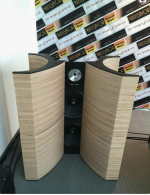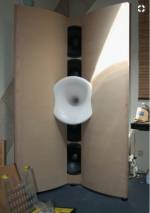??? Notice the construction, the driver mounts to the rear of a flat baffle, which the horn flares terminate at the front, so there's a baffle thickness depth 8"x16" slot [same area as the driver's 'Sd'], so a 1:1 compression ratio [CR]: http://www.lansingheritage.org/images/altec/plans/1960's-lf-design/page14.jpg
Of course one can make a phase plug that leaves as little gap as you want, but it would be a bad plan overall in the VOTT cabs and why AFAIK no one has tried and admitted to it.
Severely reduce its rear chamber to a small vented one to create a 6th order compression horn though and you wind up with a powerful ~200-600 Hz lower mids horn.
GM
Of course one can make a phase plug that leaves as little gap as you want, but it would be a bad plan overall in the VOTT cabs and why AFAIK no one has tried and admitted to it.
Severely reduce its rear chamber to a small vented one to create a 6th order compression horn though and you wind up with a powerful ~200-600 Hz lower mids horn.
GM
Thanks GM for your enlightened and helpful response. And with that I have more questions: Does this approach to design apply to all woofer's SD? And if so, is it necessary to have the rear chamber reduced to create the 6th order compression? Lastly, is this a principle that one can apply to open baffles that use the side panels for the same effect as a horn flare? Your help is appreciated.
You're welcome!
If I understand the Q, then yes.
Not per se, i.e., the A7 cab and its many variations is technically a 6th order compression horn; IOW, as one reduces the driver's low pass filter [front] chamber volume [Vb], the smaller the compression [rear] chamber's [Vb] ideally needs to be to null [balance out] the acoustic load on the diaphragm.
Since the front chamber is acoustically just the air mass plug filling up the recess cone, i.e. acts as a flat disc radiator, the back chamber is only balancing out the horn's acoustic reactance, which isn't much since it's so truncated that it's little more than a large tapered vent, only loading < octave, then acting as a collapsing on axis waveguide [WG] out to ~ 1 kHz and why it can be tuned over a wide range without impacting the horn's response.
GM
If I understand the Q, then yes.
Not per se, i.e., the A7 cab and its many variations is technically a 6th order compression horn; IOW, as one reduces the driver's low pass filter [front] chamber volume [Vb], the smaller the compression [rear] chamber's [Vb] ideally needs to be to null [balance out] the acoustic load on the diaphragm.
Since the front chamber is acoustically just the air mass plug filling up the recess cone, i.e. acts as a flat disc radiator, the back chamber is only balancing out the horn's acoustic reactance, which isn't much since it's so truncated that it's little more than a large tapered vent, only loading < octave, then acting as a collapsing on axis waveguide [WG] out to ~ 1 kHz and why it can be tuned over a wide range without impacting the horn's response.
GM
Thanks for the great info. Would all this apply to those designs I have attached? They have used the baffle to form a horn in the front but they haven't created the compression in the rear. Are there other criteria for these kinds of designs, as open baffles? If so, what are the advantages/disadvantages of them? Thanks in advance for your response.
Attachments
In theory, but haven't experimented with dipole horns except for a true reactance annulled one, which was a hyperbolic flared BLH that controlled/damped the driver's diaphragm so well it could only output > ~ -15 dB relative to the horn's output. IOW it in theory needed a negative displacement compression [rear] chamber, so left it open.
GM
GM
A little bit.......... They're nothing more than a multiple vent reflex [as opposed to the originally presumed TL alignment] and as such add a lot of vent pipe 'organ' harmonics that comb filter with the driver's mid bass, lower mids [harmonic distortion, though euphonic to many].
Some like me though wound up damping and/or stuffing the vents, so prefer single large vent column/tower alignments [aka MLTL nowadays], which are well damped 'tight'/'dry' and easier to build, fine tune.
GM
Some like me though wound up damping and/or stuffing the vents, so prefer single large vent column/tower alignments [aka MLTL nowadays], which are well damped 'tight'/'dry' and easier to build, fine tune.
GM
- Status
- This old topic is closed. If you want to reopen this topic, contact a moderator using the "Report Post" button.
- Home
- Loudspeakers
- Multi-Way
- Altec Voice of the theater worth the hassle?

